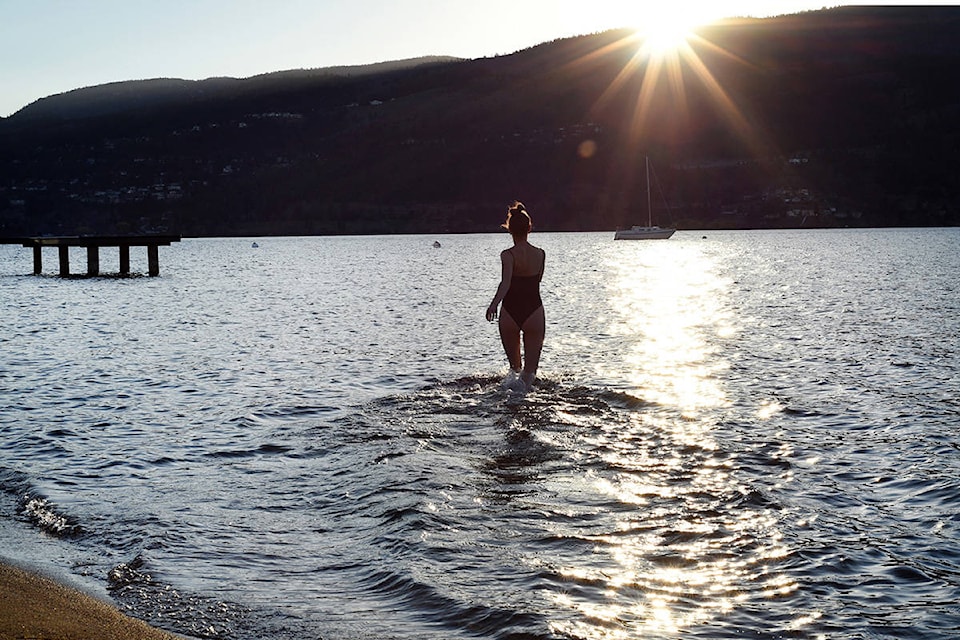- Words by Toby Tannas Photography by Lia Crowe and Don Denton
It’s been a few years now since I first dipped my toe into the proverbial waters of cold therapy. It was more of a plunge, really, and it occurred on New Year’s Day, 2018.
After enduring a particularly challenging year, I was convinced by a German-born man (who would later become my husband) that submerging my body in the frigid waters of Okanagan Lake would signify a new beginning and help me to better tackle whatever challenges lay ahead.
I don’t think I was quite ready to receive any of the benefits from the water on that day. The shock of the frigid lake made me angry. I was so put off by the extreme discomfort that I didn’t speak to my friend for the rest of that day (and maybe the next), and I didn’t go near any kind of water that might produce a goose bump for the next two years.
But early in 2020 something changed. I learned about Wim Hof and his theory that cold water plunges bring about a cascade of health benefits. Also known as “The Iceman,” Hof is a Dutch extreme athlete noted for his ability to withstand freezing temperatures. He has developed the Wim Hof Method, which is a program for good health based on breathing, cold therapy and commitment.
Hof claims that cold therapy can help with everything from anxiety and weight loss to boosting mood and strengthening the immune system.
So, on that first day in 2020, I flipped my shower to cold—just 15 seconds to start. I worked up to 30 seconds, then 45, 60 and ultimately two minutes. Deep breathing is the key and while it never gets easier, there is a certain rush that follows a cold shower, which I can only describe as addictive.
I’ve now graduated to weekly dips in Okanagan Lake. My gumption is fortified by a small group of hearty souls who are equally committed to what sometimes feels like self-induced torture. My husband (that German guy) is among them and he’s even joined a band of “ocean-dippers” in Victoria, where he frequently travels for work.
Through reading and mostly online research, we learned that three minutes submerged is the magic number; it’s enough time to kickstart the purported health benefits. We stay in four minutes for good measure.
Do I like it? No. Will I continue to do it? Yes. And therein lies the complexity of doing something solely for the perceived health benefits. Cold water therapy is the cod liver oil of the previous generation. It’s terrible, but “they” say it’s good for you.
“They” are a growing number of performance coaches, recovery specialists and naturopaths. Chelsea Gronick is a Kelowna-based naturopathic doctor. She says modern science is starting to actively research and look more closely at cold water therapy; however, versions of hydrotherapy have been used for centuries to stimulate certain responses from the body.
“When the body is exposed to cold, the sympathetic nervous system is activated. That’s the fight-or-flight response. Hormones like adrenaline are released, the heart rate increases and blood vessels constrict forcing blood to your core,” she explains. “Once the body regulates it switches to a rest/relax/restore or parasympathetic nervous system. This training of your nervous system is a way to teach your body how to regulate when faced with various stressors, not just cold water but things that come up in daily life.”
The benefits have been shown to go well beyond improving stress tolerance. Cold water therapy can induce a stronger immune system response, increase metabolism, speed up weight loss (fat burning kicks in when shivering is induced), increase energy and improve sleep quality. It may even lower inflammation so the body can heal more quickly.
Dr. Gronick does have words of caution for those brave enough to explore cold water therapy. Go slow, she says: it’s important to gradually introduce cold water and increase your tolerance.
“A great starting point would be to end your showers at a temperature as cold as you can stand for 30 to 60 seconds. Practice good judgment and slowly work your way into this therapy to mitigate the potential risks.”
Risks can include hypothermia, hives and blistered skin if the water is extremely cold or if you stay in too long.
With mainstream science just starting to come around to the idea, one can really only go on how cold water makes you feel. My small group of dippers is flourishing with repeated exposure. All of us agree it is a weekly rejuvenation, and more and more people seem to be feeling the same way. We’re no longer the only ones at the beach, proving a winter swim is no longer reserved for those New Year’s Day polar bear dippers and hardcore northern Europeans in Speedos.
A cold water dip always comes with hoots and hollers from passersby, some snap photos and without fail someone always shouts, “How’s the water?”
The answer is obvious—it’s always cold (really cold) but there’s a kind of magic about it that’s making it one of the hottest wellness trends of 2021.
Will you be giving cold water therapy a try? Tag us in your cold water photos @boulevard_magazine
Story courtesy of Boulevard Magazine, a Black Press Media publication
Like Boulevard Magazine on Facebook and follow them on Instagram



